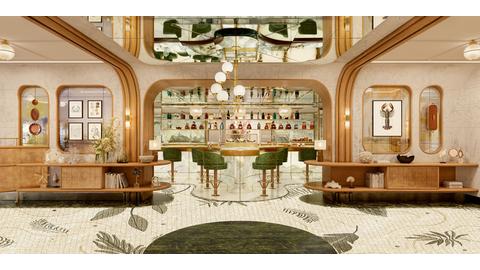Analyses & Studies • Sectors & markets • Foresight • Publications
HongKongEcho: Tourism Board plays the culture card for Hong Kong

Heritage has long been left by the wayside in Hong Kong. But with tourists demanding a more authentic taste of the city, the Hong Kong Tourism Board is playing to a new tune.
“Hong Kong has relied on shopping as its key tourism drawcard for the past 50 years. About 10 years ago we asked ourselves if that would be enough to carry the city forward. The answer, clearly, was no,” says Anthony Lau, Executive Director of the Hong Kong Tourism Board (HKTB). In order to go beyond its shopping paradise reputation, he affirms that the city needs to develop a more varied tourism offer for a range of visitor expectations.
That’s, of course, not a new reflection.
 |
| Anthony Lau, Executive Director of the Hong Kong Tourism Board (HKTB) |
As the government-funded body responsible for marketing and promoting the best the city has to offer, HKTB’s response has been to draw up a menu of 10 experiences it believes will cater to the ever-varying demands of visitors.
Dining, nightlife, entertainment, festivals, sporting events, arts happenings, living culture, attractions, great outdoors, and shopping make up the list.
Arguably, much of this is not new. But it’s all about how you package it, according to Lau. That’s where HKTB is looking to leverage Hong Kong’s heritage as a way of marketing to visitors who expect more than the tried and tested hotspots.
A new type of tourist
Which visitors, you ask? Of Hong Kong’s 65 million annual visitor arrivals roughly half are same-day visitors (overwhelmingly from mainland China), making an in-depth foray into heritage and culture an unlikely drawcard.
But among the other 30-or-so million Lau pinpoints a group HKTB classifies as the ‘cultural explorers’. Marketing jargon aside, these tend to be visitors from long-haul markets like Europe, the United States, Australia, Japan, parts of South East Asia, as well as mainland Chinese tier 1-2 cities.
They’ve been to Hong Kong before. They know its main sites. And crucially, they want to get beneath the city’s skin and understand its culture.
 |
| Culture-savvy tourists from long-haul markets are the new major target for the Hong Kong Tourism Board |
“Our approach in the past has been simply to highlight various points of interest without any story-telling or context. Heritage is much more than just old buildings, it’s very much part of our people and who we are,” says Lau. HKTB’s latest push is a district-focused effort called the Neighbourhood Programme which aims to package neighbourhoods in a way which will immerse visitors in the story of locals and their heritage, one district at a time.
Districts in focus
The programme kicked off in 2017 with the ‘Old Town Central’ campaign, essentially giving a layer of heritage branding to a district often considered a business-only nest of skyscrapers. Suggested itineraries and historical insights punctuate its dedicated section on the HKTB website directing visitors to some of the less-travelled sites like Jamia Mosque in Mid-Levels – the very first in Hong Kong. QR codes on signage throughout the neighbourhood likewise point wandering travellers on to suggested walks through inbuilt Google Maps routes.
In late 2018, HKTB launched the latest district focus, turning its attention to Sham Shui Po in a HK$12 million marketing campaign. The gritty Kowloon neighbourhood is one of Hong Kong’s lowest-income areas; a living retrospective to what the city looked and felt like before modern redevelopment took hold in earnest. Its culinary offerings – mostly featuring old Cantonese wares not easily found elsewhere – have earnt a loyal following. Eight (exceptionally affordable) Michelin stars are somewhat unexpectedly scattered throughout the neighbourhood.
It’s certainly the ‘authentic’ Hong Kong many visitors crave – partly by virtue of being off the tourist map in the first place. So how do you actually keep it that way? “It’s a question tourism marketers are always discussing and I’m not sure anyone really has a good solution yet. At the end of the day, I think we should remember there are real economic benefits of tourism. Why shouldn’t Sham Shui Po benefit also?”
 |
| Sham Shui Po gets the 'Go!' from HKTB in a HK$12 million marketing campaign |
Dispersing throngs of tourists away from over-crowded go-to locations like Causeway Bay and Tsim Sha Tsui is also part of the consideration, says Lau.
The branding and packaging is all well and good. But real questions have been raised as to whether this discourse matches the government’s perceived lack of interest in preserving the last remaining heritage buildings or other cultural elements like the city’s dai pai dong food stalls.
“I think the government has improved a lot in recent years,” says Lau. Landmark redevelopment projects like Tai Kwun, PMQ and the Mei Ho House Youth Hostel (which received an honourable mention from the UNESCO Asia-Pacific Heritage Awards for Cultural Heritage Conservation) – among others – have brought largely positive rejuvenation to heritage buildings.
“It always comes down to a fine balance. We have to remember that Hong Kong is a small territory with a growing population – obviously I think we should preserve heritage where we can, or even relocate certain buildings, but not necessarily at the cost of development.”









